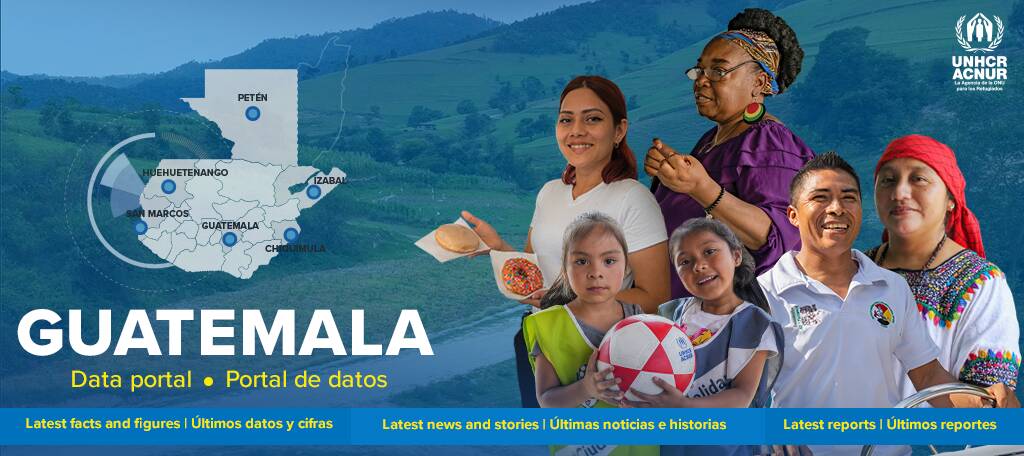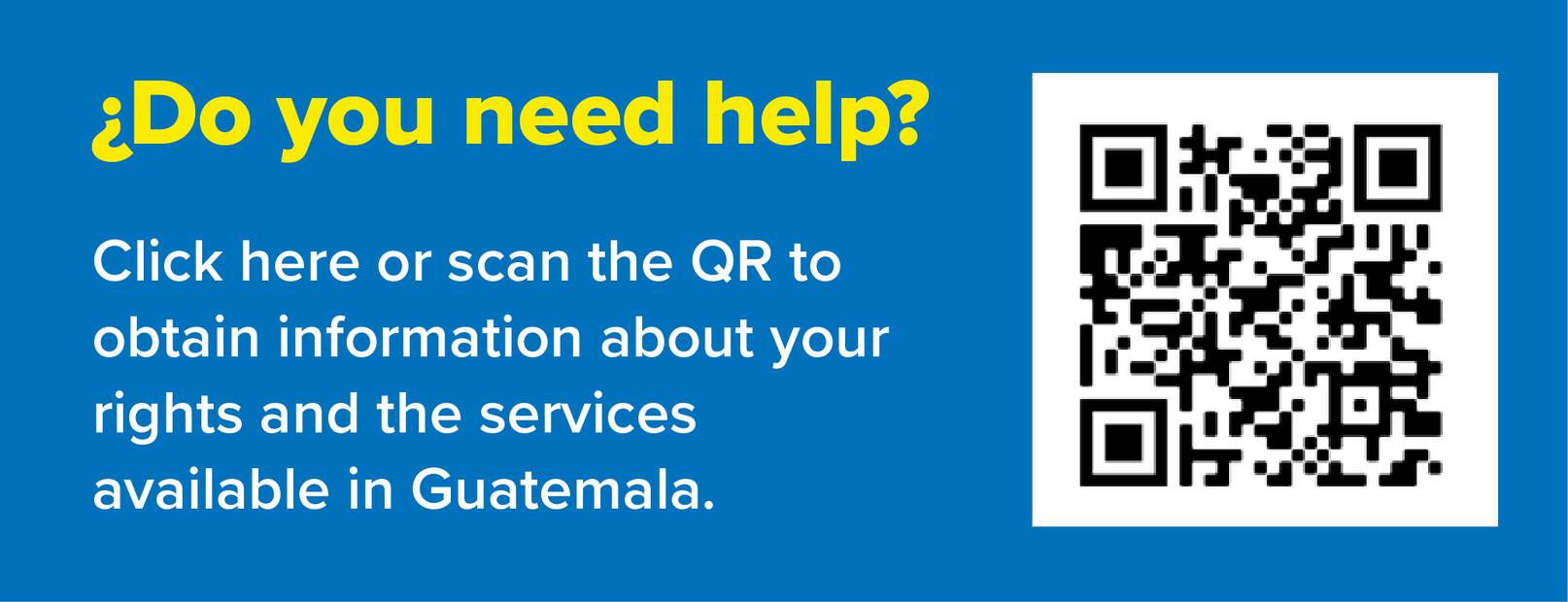
JSON
| Country of origin | Source | تاريخ البيانات | Population | |
|---|---|---|---|---|
| El Salvador | Government, UNHCR | 31 Dec 2022 | 37.6% | 842 |
| Honduras | Government, UNHCR | 31 Dec 2022 | 30.5% | 683 |
| Nicaragua | Government, UNHCR | 31 Dec 2022 | 15.7% | 351 |
| Venezuela (Bolivarian Republic of) | Government, UNHCR | 31 Dec 2022 | 10.1% | 226 |
| Others | Government, UNHCR | 31 Dec 2022 | 3.3% | 74 |
| Colombia | Government, UNHCR | 31 Dec 2022 | 1.7% | 37 |
| Cuba | Government, UNHCR | 31 Dec 2022 | 1.3% | 29 |
Forced displacement in and from El Salvador, Guatemala and Honduras | October 2024
Documentتاريخ الانشاء: 24 October 2024 (9 months ago)
Mixed Movements Monitoring Report | UNHCR-WFP-UNICEF | Q2 2024
Documentتاريخ الانشاء: 27 September 2024 (10 months ago)
Ciudades Solidarias - Buenas Prácticas
Documentتاريخ الانشاء: 24 September 2024 (10 months ago)
Guatemala: Ciudades Solidarias, Septiembre 2024
Documentتاريخ الانشاء: 24 September 2024 (10 months ago)
Guatemala: Actualización Protección Comunitaria - junio 2024
Documentتاريخ الانشاء: 31 July 2024 (1 year ago)
Guatemala: Ciudades Solidarias, Septiembre 2024
Documentتاريخ الانشاء: 24 September 2024 (10 months ago)
ACNUR en Guatemala
Documentتاريخ الانشاء: 1 June 2024 (1 year ago)
UNHCR in Guatemala
Documentتاريخ الانشاء: 1 June 2024 (1 year ago)
Oficina de Terreno de Guatemala
Documentتاريخ الانشاء: 1 June 2024 (1 year ago)
Guatemala Field Office
Documentتاريخ الانشاء: 1 June 2024 (1 year ago)
The Americas - UNHCR's total resettlement capacity for 2017 by country of asylum - 25 May 2016
Documentتاريخ الانشاء: 23 January 2017 (8 years ago)
Northern Triangle of Central America - UNHCR Presence- 2016 Solutions and Protection Strategy - 15 December 2015
Documentتاريخ الانشاء: 17 January 2017 (8 years ago)
Northern Triangle of Central America - Main displacement patterns - December 2015
Documentتاريخ الانشاء: 17 January 2017 (8 years ago)
The Americas - UNHCR Presence - 13 January 2016
Documentتاريخ الانشاء: 17 January 2017 (8 years ago)
The Americas - UNHCR Presence - 04 March 2016
Documentتاريخ الانشاء: 17 January 2017 (8 years ago)
Overview of internal displacement in Honduras
Documentتاريخ الانشاء: 11 August 2017 (8 years ago)
“Acortemos distancias”, nueva campaña de solidaridad con las personas refugiadas y migrantes en América Latina y el Caribe – Agosto 2020 [ES...
Documentتاريخ الانشاء: 24 August 2020 (4 years ago)
R4V Launches “One Step Closer,” A Campaign in Solidarity with Refugees and Migrants in Latin America and the Caribbean – August 2020 [EN]
Documentتاريخ الانشاء: 24 August 2020 (4 years ago)
Forced displacement in and from El Salvador, Guatemala and Honduras | October 2024
Documentتاريخ الانشاء: 24 October 2024 (9 months ago)
Mixed Movements Monitoring Report | UNHCR-WFP-UNICEF | Q2 2024
Documentتاريخ الانشاء: 27 September 2024 (10 months ago)
Ciudades Solidarias - Buenas Prácticas
Documentتاريخ الانشاء: 24 September 2024 (10 months ago)
ACNUR Guatemala: Monitoreo de Movimientos Mixtos | Informe enero - abril 2024
Documentتاريخ الانشاء: 10 July 2024 (1 year ago)
UNHCR Guatemala - Livelihoods and Economic Inclusion 2023 Newsletter. Executive Summary.
Documentتاريخ الانشاء: 15 May 2024 (1 year ago)
Mixed Movements Monitoring Report | UNHCR-WFP-UNICEF | Q2 2024
Documentتاريخ الانشاء: 27 September 2024 (10 months ago)
ACNUR Guatemala - Reporte de Monitoreo Post Distribución (PDM) - 2022
Documentتاريخ الانشاء: 10 August 2023 (2 years ago)
UNHCR Guatemala - Post Distribution Monitoring Report (PDM) - 2022
Documentتاريخ الانشاء: 10 August 2023 (2 years ago)
UNHCR Guatemala - Operational Update (Jan-Apr 2023)
Documentتاريخ الانشاء: 8 June 2023 (2 years ago)
ACNUR Guatemala - Actualización Operativa (En-Abr 2023)
Documentتاريخ الانشاء: 8 June 2023 (2 years ago)
Guatemala: Newsletter - July 2022
Documentتاريخ الانشاء: 13 July 2022 (3 years ago)
Guatemala: Boletin - Julio 2022
Documentتاريخ الانشاء: 13 July 2022 (3 years ago)
GTRM - Informe de Situación Ecuador - Febrero 2019 [ES]
Documentتاريخ الانشاء: 19 June 2019 (6 years ago)
Guatemala: Boletín - Junio 2022
Documentتاريخ الانشاء: 15 June 2022 (3 years ago)
Guatemala: Newsletter - June 2022
Documentتاريخ الانشاء: 15 June 2022 (3 years ago)
Guatemala: Newsletter - May 2022
Documentتاريخ الانشاء: 31 May 2022 (3 years ago)
Guatemala: Boletín - Mayo 2022
Documentتاريخ الانشاء: 31 May 2022 (3 years ago)
Guatemala: Newsletter - July 2022
Documentتاريخ الانشاء: 13 July 2022 (3 years ago)
Guatemala: Boletin - Julio 2022
Documentتاريخ الانشاء: 13 July 2022 (3 years ago)
Guatemala: Actualización Protección Comunitaria - junio 2024
Documentتاريخ الانشاء: 31 July 2024 (1 year ago)
-
Guatemala - Central America & Mexico
Forced displacement continues to grow in numbers, and in complexity. Gang violence, persecution and human rights violations have left no other choice for around 720,000 people from the North of Central America but to flee either internally or across borders. The social and political crisis in Nicaragua since April 2018 has forced over 100,000 nationals to neighboring countries. UNHCR has expanded its presence and operational capacity in recent years to strengthen protection alternatives and facilitate solutions for those affected.
Guatemala plays a significant role in the mixed movements in Central America, serving as a country of origin, transit, destination, and return location for asylum-seekers, refugees, returnees, and migrants. These populations have distinct needs and backgrounds, including survivors of trafficking, victims of gender-based violence, unaccompanied or separated children, and LGBTIQ individuals. While traditionally, flows originated from Honduras, El Salvador, and Nicaragua, the country experienced a significant increase in Venezuelans and Haitians in the last years. Additionally, many Guatemalans face numerous risks within their country, including insecurity, violence, and a lack of sustainable livelihoods. As a result, many of them are compelled to seek international protection. Nevertheless, despite these challenges, the number of Guatemalans forced returned has steadily risen each year, exacerbating their vulnerabilities and exposing them to further dangers.
To address the needs of people in mixed movements and identify those with international protection needs, UNHCR has established six field offices located in critical transit points as they share borders with Mexico, Honduras, and El Salvador. Furthermore, UNHCR collaborates closely with the government and civil society organizations to ensure access to territory, documentation, protection referral mechanisms, international protection solutions, basic services, and urgent needs for refugees, asylum-seekers, and Guatemalans at risk. Additionally, UNHCR and its partners operate in five Migrant and Refugee Assistance Centres (CAPMiRs) to cover entry and exit borders and transit routes and reinforce the national response to people in mixed movements by identifying persons with international protection needs and providing solutions.
| Date of Funding Data | 27 June 2023 (2 years ago) |
For more information, please contact the following focal points
| Type of Inquiry | Contact |
|---|---|
| Associate Information Management Officer | Pedro Martinez [email protected] |
| Associate Reporting Officer | Flavia Faria [email protected] |

































